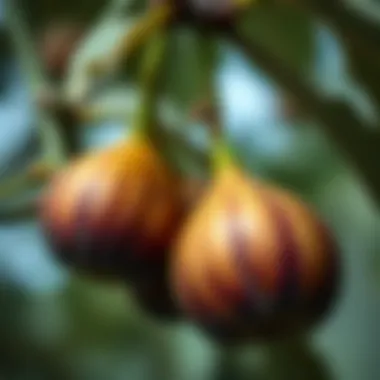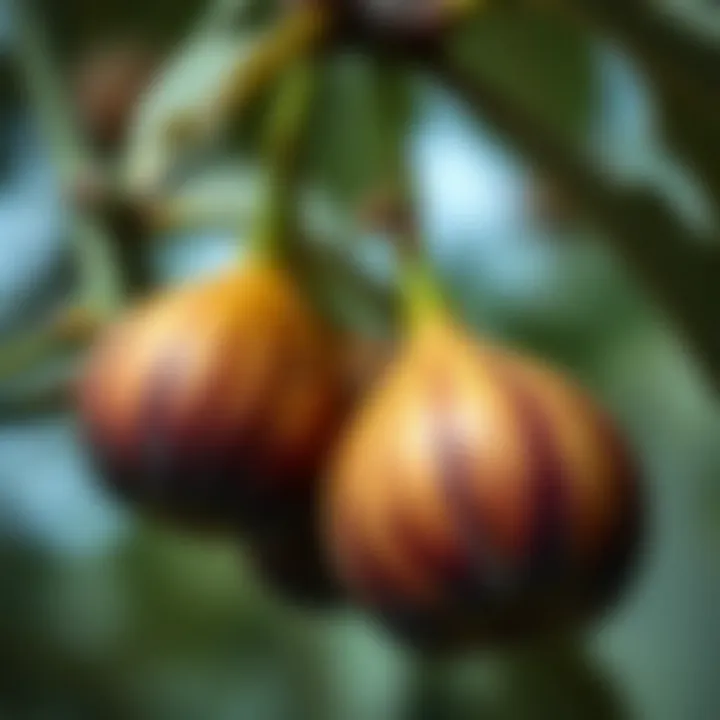Exploring Mediterranean Figs: History and Benefits


Intro
Mediterranean figs have captivated people's hearts and palates for centuries. With their unique flavor profile and versatility, these fruits stand as treasured components of Mediterranean culture and cuisine. But the allure of figs goes far beyond just food; their historical significance and roles in local economies offer a window into the past and present of Mediterranean societies.
Often nestled in orchards, the fig tree is believed to have accompanied humanity through various epochs, its roots deep in the soil of ancient civilizations. While figs may seem like a simple fruit at first glance, a closer inspection reveals a complex interplay of environmental conditions, traditional agricultural methods, and health benefits—each facet enriching the understanding of this beloved fruit.
Through this exploration, we are not just peeling back the layers of knowledge surrounding Mediterranean figs; we are also celebrating their resilience and how they adapt to modern diets, ensuring their continued prominence in a rapidly changing world. As we embark on this comprehensive examination, readers will discover the depths of nutritional values, cultivation practices, and cultural impacts of figs, all while engaging with the ongoing dialogue about sustainable farming and health trends.
This engaging narrative will serve to cultivate a deeper appreciation for figs as well as highlight their multifaceted presence in our daily lives.
Botanical Overview of Mediterranean Figs
Understanding the botanical aspects of Mediterranean figs is crucial for not only appreciating their unique attributes but also recognizing their role in agriculture and nutrition. By delving into the classification and specific species, as well as their morphological characteristics, we uncover the foundation of what makes these fruits so special. This section offers insights into how Mediterranean figs thrive in their environment, which can help we understand their cultivation practices and nutritional advantages.
Classification and Species
Mediterranean figs, belonging to the genus Ficus, primarily encompass the species Ficus carica. This fig species is widely cultivated for its edible fruit. The classification places figs within the Moraceae family, highlights their relationship with other plants in the family, like mulberries and breadfruit.
- Common Varieties: Among the various species encountered in the Mediterranean, Ficus carica is further divided into several cultivars, each boasting distinctive flavors and textures. Some of the popular types include:
- Brown Turkey: Known for its sweet taste and smooth texture.
- Adriatic: Recognized for its vibrant green color and exceptional sweetness.
- Caprifig: Essential for pollination, its role is critical but not for consumption.
Details like these help us grasp why Mediterranean figs have taken such a prominent place in the region's culinary and agricultural landscapes. The natural variations among species contribute not only to biodiversity but also to the adaptability of figs in various climates.
Morphological Characteristics
Morphologically, Mediterranean figs present an array of fascinating features that can capture anyone's attention. The trees typically reach heights of 10 to 30 feet, with broad leaves that can span up to a foot wide. The leaf structure often presents a distinct shape, varying from lobed to unlobed.
The fruit itself is a standout characteristic. Figs grow as small, fleshy syconia—a structure that provides protection for the flowers. Once mature, they can either be green, purple, or even yellow, depending on the variety. The inside reveals a unique combination of seeds, pulp, and a juicy texture that holds sweetness unparalleled in the fruit kingdom.
- Physical Traits of Mediterranean Figs:
- Weight: Can range from 50 grams to 60 grams at maturity.
- Color Variations: Depend on the specific cultivar, with hues varying widely.
- Flavor Profile: Ranges from sweet to mildly tart.
Understanding these morphological traits not only enhances appreciation for Mediterranean figs but also aids in better cultivation practices and informs consumers about the best varieties to select for their needs.
The morphological diversity of Mediterranean figs not only enriches their culinary appeal but also contributes to ecological balance in their native habitats.
As we navigate the intricate world of figs, we can see how vital these aspects are for local economies, cultural practices, and nutritional profiles. More than just a fruit, Mediterranean figs interweave into the very fabric of life in the Mediterranean region.
Historical Context and Significance
Historically, Mediterranean figs carry a rich tapestry of significance intertwined with human civilization. Not just a fruit, they can serve as an emblem of the area’s agricultural heritage, reflecting the climate, the land, and the people who cultivate them. These figs have played crucial roles in various cultures for thousands of years, influencing cuisines, economies, and traditions. Understanding this context provides insights into the integral role figs have played not only as food but also as a part of social fabric in the Mediterranean.
Origins in the Mediterranean Basin
The genesis of the Mediterranean fig can be traced back to the Mediterranean Basin, an area that has provided the optimal conditions for these particular fruits to thrive. The first known domestications of figs happened over 6,000 years ago in this region, notably in areas stretching from modern-day Turkey to the islands of Greece.
Some studies suggest that figs might be among the first plants cultivated by humans. Notably, the fig appears in ancient texts and artifacts, revealing its longstanding presence in human diets. Archaeological findings in places like Çatalhoyuk in Turkey showcase primitive farming practices involving this fruit, underscoring its early importance in sustaining communities. The Mediterranean climate, characterized by hot, dry summers and mild, wet winters, offers the perfect environment for growing figs, ensuring their survival and abundance.
The fig tree's adaptations to the local climate—such as drought resistance—have allowed it to flourish even in challenging conditions. As a result, it has become a staple in local diets and trade, with specific varieties cultivated to meet regional tastes. Notably, the ancient Greeks revered the fig, associating it with the goddess Demeter, and using it in various rituals, showing its dual role as sustenance and symbol.
Cultural Roles through History
Figs have not just fed bodies; they've nourished cultures across centuries. In ancient Rome, they were seen not only as a delicious treat but also as a symbol of wealth and prosperity. The Roman poet Horace even wrote about the delights of figs, appreciating their sweetness and the joy they brought during mealtime.
In many Mediterranean cultures, figs embody more than just a fruit; they are woven into the fabric of social gatherings, rituals, and even art. For instance, celebrations in southern Spain during the harvest season reflect age-old traditions tied to fig picking and processing. Communities come together to share these fruits, reinforcing social bonds and heritage.
"In the Mediterranean, the fig is not merely food. It is a connection to the land, the history, and the people. Each bite tells a story."
In literature and religion, figs have also held symbolic meanings. The fig tree appears in numerous texts, including biblical references, where it stands for peace and prosperity. This symbolism is prevalent even in modern times, where figs are often part of festive tables, used in both savory and sweet dishes, preserving their cultural significance.
Today, Mediterranean figs continue to thrive in local markets, culinary fusions, and innovative cooking, marrying history with modernity. They are not only a testament to agricultural practices but also a common thread through diverse Mediterranean narratives, reminding us of the deep roots they have in this region's history.
Cultivation Practices
Cultivation practices play a vital role in the successful growth of Mediterranean figs. These practices not only influence the yield and quality of the fruit but also determine the sustainability of fig farming in the region. Understanding these methods can reveal much about the delicate balance between tradition and modernity in agriculture.
Traditional Farming Techniques
For centuries, farmers in the Mediterranean have developed practices that reflect their deep connection with the land. Traditional fig farming often involves techniques handed down through generations.
- Site Selection: Farmers usually choose land that has well-draining soil, as figs do not thrive in waterlogged conditions. The choice of terrain can make a significant difference. Steep hillsides, for example, allow for natural drainage and provide the sunny conditions figs need to ripen.
- Pruning: This practice is crucial for ensuring healthy growth. Pruning not only encourages branching but also allows for better sunlight penetration, leading to more fruitful crops. Farmers often prune their fig trees in late winter, preparing them for the growing season.
- Intercropping: Some farmers employ intercropping methods, growing figs alongside other crops. This not only optimizes land use but can also support biodiversity. Plants like grapes and olives complement figs as they have similar soil and water requirements.
- Natural Pest Control: Many fig farmers avoid chemical treatments, opting instead for natural methods like attracting beneficial insects. This approach nurtures a healthier ecosystem around fig orchards.
Modern Agricultural Innovations
As the global market for figs expands, innovative agricultural techniques have begun to complement traditional methods. These innovations are driving efficiency and improving the quality of the figs produced.
- Drip Irrigation: With water scarcity becoming a pressing issue, drip irrigation has emerged as a game-changer. It delivers water directly to the roots, reducing waste and promoting healthier plant growth. This efficient method ensures that figs receive the hydration they need without overusing precious resources.
- Organic Fertilizers: Sustainable practices have led to the adoption of organic fertilizers, such as compost and manure. These amendments enhance soil health and create more nutrient-rich fruit. The push for organic figs also caters to rising consumer demand for natural products.
- Disease Resistance: Advances in genetic research are paving the way for developing fig varieties that are more resistant to diseases and pests. This not only increases yield but also reduces the need for chemical controls.
- Precision Agriculture: Modern technology now allows farmers to monitor their crops with unprecedented accuracy. Tools like drones and soil sensors help assess the health of fig trees in real time, enabling targeted interventions that can boost productivity.
The marriage of tradition and innovation in fig cultivation is essential for meeting current and future demands while ensuring sustainability in the Mediterranean.
The evolving landscape of fig farming showcases the fascinating synergy of age-old wisdom and modern technology, each enhancing the resilience and richness of Mediterranean fig culture. As these practices advance, they continue to ensure that figs remain a cherished fruit, both locally and globally.


Nutritional Profile
Understanding the nutritional profile of Mediterranean figs is crucial for appreciating their role in both diet and health. The unique combination of vitamins, minerals, and dietary fiber found in figs contributes to an array of health benefits. These attributes not only enhance the dietary value of figs but also support their status as a significant component in Mediterranean cuisine.
Vitamins and Minerals in Figs
Mediterranean figs boast a rich array of vitamins and minerals, making them not just a tasty treat but a noteworthy addition to a well-balanced diet. Here are some of the essential nutrients found in figs:
- Vitamin B6: Important for protein metabolism and cognitive function, this vitamin also plays a role in the production of neurotransmitters, which can influence mood and brain health.
- Calcium: Figs are a natural source of calcium, essential for maintaining strong bones and teeth.
- Potassium: This mineral is vital for heart health, blood pressure regulation, and muscle function. Figs contain a good amount of potassium which can help balance sodium levels in the body.
- Magnesium: Vital for over 300 biochemical reactions in the body, magnesium can support everything from muscle and nerve function to energy production.
- Iron: Figs help in the production of red blood cells, which means they play a part in preventing anemia.
Moreover, figs are a source of antioxidants like beta-carotene and lutein which help combat oxidative stress in the body, potentially reducing the risk of chronic diseases. As an essential fruit in the Mediterranean diet, figs exemplify a fusion of taste and nutrition, allowing such ingredients to play a role not just in flavor but also in overall well-being.
"Nutrient-rich foods like figs can contribute to a balanced diet, supporting various health functions while providing flavor and versatility."
Fiber Content and Digestive Health
Figs are particularly well-known for their high fiber content, which forms a significant part of their nutritional appeal. Here's how the fiber in figs can benefit digestive health:
- Promotes Healthy Digestion: The soluble fiber in figs aids in softening stool and facilitating regular bowel movements. This can help combat constipation—a common digestive issue.
- Supports Microbiome Health: Figs can act as prebiotics, which nourish the beneficial bacteria in the gut. A healthy microbiome is linked to improved digestive health and overall wellness.
- Appetite Regulation: Dietary fiber helps maintain fullness between meals, which can be advantageous for weight management. This characteristic may enhance their effectiveness in a weight management program.
- Stabilizes Blood Sugar Levels: The fiber in figs slows down the absorption of sugar into the bloodstream, thus helping to regulate blood sugar levels, an essential aspect for individuals managing diabetes.
With each serving of figs, you’re not just indulging your taste buds; you’re also offering your gut a feast of fiber, essential for maintaining digestive health. As you dive deeper into the Mediterranean fig's nutritional profile, it's clear that this fruit plays a multifaceted role in supporting a healthy lifestyle.
Health Benefits of Mediterranean Figs
Mediterranean figs, those luscious fruits rich in flavor and texture, bring not just palate satisfaction but a heaping helping of health benefits as well. When one considers the broad advantages of these figs, it becomes strikingly evident that they are much more than a delightful snack or cooking ingredient. Health-conscious individuals, nutrition enthusiasts, and culinary experts alike ought to take note of the significance of figs in their dietary practices. This section will unravel the myriad ways in which figs contribute to well-being, with a focus on heart health, weight management, and their antioxidant properties.
Impact on Cardiovascular Health
The heart is undeniably one of the most critical parts of the human body, and surprisingly, Mediterranean figs play an essential role in ensuring its health. Rich in potassium, which helps maintain proper blood pressure, these figs can be invaluable in Reducing the chances of heart disease. Not just that, but the fiber content present in figs, particularly soluble fiber, can assist in lowering cholesterol levels.
- Potassium's Role: This mineral helps in maintaining fluid balance and can help in regulating blood pressure. A balanced potassium intake is paramount for those looking to support cardiovascular health.
- Cholesterol Reduction: Soluble fiber absorbs water and forms a gel-like substance in your digestive tract, which helps lower harmful LDL cholesterol, thereby promoting a healthier heart.
A study highlighted by the American Journal of Clinical Nutrition pointed out that a diet rich in fruits like figs can decrease cardiovascular risk factors. Individuals aiming for heart health should certainly consider integrating figs into their diets.
Role in Weight Management
For those on a weight management journey, Mediterranean figs can act as both a friend and a valuable ally. Despite their natural sweetness, they have a relatively low caloric density when compared to many other snacks. This means one can enjoy them without derailing their goals.
- Satiety Factor: Packed with dietary fiber, figs help keep you feeling full for longer, reducing the temptation to snack on less healthy options. This fullness can help curb those pesky cravings.
- Natural Sweetness: In a world where added sugars run rampant, figs offer a delightful alternative. Their natural sweetness satisfies sugar cravings, and can thereby assist in avoiding unhealthy desserts.
Moreover, integrating figs into meals can foster mindful eating practices, as their unique texture and flavor encourage savoring each bite.
Antioxidant Properties
Antioxidants are crucial in combating oxidative stress and lowering the risk of chronic diseases, and Mediterranean figs might just be one of the unsung heroes in this realm. Full of phenolic compounds, vitamins, and carotenoids, these figs equip the body to fight against free radicals.
- Rich in Phenolic Acids: These compounds not only help neutralize harmful free radicals but also exhibit anti-inflammatory properties. By including figs in one's diet, you could bolster your defense against inflammation-related diseases.
- Tackling Cellular Damage: Regular consumption of figs has been linked with enhanced cellular health, effectively working to protect DNA from damage and thereby potentially lowering cancer risks.
"The array of antioxidants in figs could serve as a formidable barrier against chronic diseases, making them a worthy addition to any health-conscious diet."
Fig Varieties in the Mediterranean Region
The Mediterranean region, with its diverse climate and rich agricultural heritage, is home to numerous fig varieties that each possess unique flavors, textures, and cultural significance. Understanding these varieties is essential, as they not only define the culinary landscape but also have economic implications for local farmers. In this section, we will spotlight a selection of popular fig varieties and probe into how these varieties have adapted to varying climatic conditions in the Mediterranean. This exploration aims to underscore the resilience and diversity within fig cultivation while elucidating the benefits of these different types.
Popular Varieties and Their Profiles
When we think about figs, some names might shine brighter than others, owing to their distinct characteristics and the roles they play in local cuisines. Here are a few notable varieties:
- Black Mission: This is one of the most recognized fig types, primarily due to its sweet, rich flavor and deep purple-black skin. It is often dried but can be enjoyed fresh as well.
- Kadota: A green-yellow variety known for its sweet, mild flavor, Kadota figs are often used in preserves and desserts. Originating from the Mediterranean, they are particularly popular in the United States.
- Smyrna: Renowned for its large size and sweet flesh, the Smyrna variety requires pollination, making it less common in regions where natural pollinators are scarce.
- Calimyrna: Similar to Smyrna, this variety is highly esteemed for its sweetness and is often marketed dried. Its cultivation reflects the agricultural tradition in Turkey.
- Panachee (Tiger Fig): This variety is unique for its striking striped skin and sweet, juicy flesh. It adds a colorful touch to any fruit platter and is especially enjoyed fresh.
Each of these varieties carries its own flavor profile, making them suitable for various culinary applications, from simple snacks to elaborate dishes.
Climatic Adaptations and Variations
Figs, inherently adaptable, thrive across the Mediterranean basin, which experiences a variety of climates ranging from arid to temperate. Each fig variety exhibits remarkable resilience, allowing them to cope with different growing conditions.
- Drought Resistance: Many Mediterranean fig varieties have evolved to endure prolonged dry spells. Their deep root systems help them draw moisture from the soil during arid months, allowing them to flourish in less-than-ideal conditions.
- Temperature Tolerance: Varieties like the Black Mission show tolerance to heat, making them well-suited for warmer regions of Spain and Italy. Conversely, others like the Kadota prefer milder climates, preferring protection from harsh winter temperatures.
- Soil Adaptability: Figs can grow in several types of soil, though they prefer well-draining sandy loam. Varieties have developed unique growth patterns based on soil conditions, with some thriving in rocky terrains where water retention is a challenge.
As climate change continues to impact traditional farming methods, understanding these adaptations can provide insights into sustainable fig cultivation practices for the future. This adaptability not only affects agricultural efficiency but also plays a crucial role in the conservation of fig diversity in Mediterranean ecosystems.
The resilience of figs exemplifies nature's ability to adapt and thrive, shaping both the agricultural patterns of the Mediterranean and the cultural practices surrounding this beloved fruit.
As we delve deeper, it becomes evident that the continued appreciation for various fig types is not merely about their taste but equally about their ability to withstand the test of time and climate.
Economic Aspects
When it comes to the Mediterranean region, figs aren't just a delicious snack; they're an economic staple. Understanding the economic aspects surrounding these fruits reveals their significant contribution to local economies, agricultural systems, and trade relations. In this section, we will explore how figs influence the livelihoods of farmers, the dynamics of markets, and the broader implications for trade on a global scale. This insight is particularly vital for students and researchers looking to grasp the multifaceted role of Mediterranean figs in economic contexts.
Figs in Local Economies
Figs hold a crucial spot in local economies throughout the Mediterranean. Smallholder farmers often rely on fig cultivation as a primary source of income due to the relatively low investment required compared to other crops. For example, farmers in Sicily might plant varieties like the Dottato or Brogiotto, known for their sweet taste and market demand. These figs not only provide sustenance for families but also bolster the local economy through their sales.
- Job Creation: The cultivation of figs requires a significant labor force. Seasonal laborers are employed to assist with harvesting, and this supports local communities, particularly in rudimentary economies.
- Tourism Linkages: In regions like Southern France, fig farms often become tourist attractions. Visitors partake in local fig festivals, contributing to the hospitality and service sectors.
- Cultural Heritage: Figs are an intrinsic part of many regional cuisines, which strengthens cultural identity and boosts local gastronomy, thus encouraging economic growth through culinary tourism.


The presence of figs impacts not just the farmers but also local artisans who might create products such as fig jams and dried figs. This creates a ripple effect in local markets, enhancing the overall economic ecosystem.
Export Markets and Global Trade
The international trade dynamic of Mediterranean figs paints a broader picture of their economic importance. As more people globally seek organic and health-oriented foods, demand for figs has surged, making export a vital avenue for Mediterranean countries. Export markets, particularly in countries like Turkey and Greece, play a significant role in the fig trade.
- Market Trends: Exports of dried figs from Turkey have increased remarkably, with the U.S. and Germany being major importers. Markets are increasingly favoring organic produce, and Mediterranean fig farmers are adapting to these shifts.
- Trade Agreements: Bilateral and multilateral agreements also influence fig exports, as countries negotiate tariffs and quotas that can either hinder or enhance market access for Mediterranean growers.
- Supply Chain Dynamics: The challenges of transporting perishable goods like fresh figs require efficient logistics. Innovations in cold storage and freight shipping have become crucial for maintaining quality, directly affecting profit margins and market competitiveness.
"The fig tree, in its silent influence, brings not only fruit but economic life to the Mediterranean lands. As the market expands, so does the story of the cultures entwined with it."
Understanding the economic aspects of figs lends insight into their larger role in sustainability and food security, essential components of the global economy. Observing how intricately tied Mediterranean figs are to local and international markets presents opportunities for further discussion on the intersection of agriculture, trade, and cultural heritage.
Environmental Implications
The discussion around Mediterranean figs extends beyond their delightful taste and nutritional profile; it touches upon the critical environmental implications tied to their cultivation. This section examines the importance of sustainability in fig cultivation and highlights the significant challenges posed by climate change.
Sustainability in Fig Cultivation
Sustainable practices in fig cultivation are paramount for ensuring the longevity of this cherished fruit. These practices not only support the environment but also enhance the quality of figs produced. Farmers are increasingly adopting methods that minimize their ecological footprint. Some key aspects of sustainability in fig farming include:
- Water Management: Efficient irrigation techniques, such as drip irrigation, reduce water usage, ensuring that this precious resource is conserved while maintaining the health of fig trees.
- Soil Health: Crop rotation and organic farming practices help in maintaining soil fertility and preventing depletion. This approach leads to a balanced ecosystem, which is vital for the sustainable growth of figs.
- Pest Control: Integrating natural pest control methods, like biological controls, reduces the reliance on harmful pesticides, resulting in cleaner and safer produce.
- Carbon Footprint Reduction: Implementing local sourcing for fig products can lower transportation emissions, giving a nod to both sustainability and freshness.
These practices not only benefit the fig farmers by lowering costs and improving yields but also protect biodiversity and ensure that future generations can enjoy the various fig varieties that thrive in the Mediterranean region.
Challenges of Climate Change
While the efforts towards sustainable fig cultivation are commendable, the shadow of climate change looms large, presenting significant challenges to both fig farmers and the ecosystems they rely on. The consequences of climate change on fig production can be alarming:
- Temperature Fluctuations: Fig trees are sensitive to changes in temperature. Unanticipated hot spells or frosts can disrupt flowering and fruiting cycles, leading to reduced crop yields.
- Water Availability: Shifts in rainfall patterns can lead to droughts in some areas while causing floods in others, affecting water availability for irrigation. Drought conditions have made it increasingly difficult for farmers to sustain their crops due to dwindling water sources.
- Pests and Diseases: Warmer climates can extend the range and lifecycle of pests and diseases that affect fig trees. This necessitates the heightened use of pesticides, contradicting sustainability efforts.
- Policy and Economic Pressures: Farmers may struggle to adapt to climate change without support from government and agricultural organizations. There's a pressing need for policies encouraging sustainable practices while providing financial assistance for those transitioning.
"Adaptation to climate change is not merely an option; for many fig growers, it is a necessity to ensure the viability of their crops amid shifting environmental conditions."
Culinary Uses of Figs
The culinary uses of figs stretch far and wide, underpinning their importance in both traditional and modern kitchens. Figs are an ancient fruit, with dynamic qualities that allow them to blend seamlessly into a variety of dishes. Whether you’re whipping up a simple snack or planning an elaborate feast, these little gems offer a burst of flavor, texture, and health benefits.
In this section, we'll unwrap how figs have not only enriched culinary traditions but also diversified contemporary cooking practices. The appeal of figs lays not just in their sweetness but also in their versatility and the rich history they bring to the table.
Traditional Dishes Featuring Figs
Figs have been a staple ingredient in Mediterranean cuisine for centuries. They appear in numerous traditional dishes, reflecting the fruit’s historical significance and regional diversity. In Italy, for instance, dried figs are often incorporated into a dish known as crostini, where they’re served atop crispy bread with a dollop of creamy cheese.
Another classic is the fig and prosciutto salad. The combination of sweet figs and salty prosciutto showcases a perfect balance of flavors, often enhanced with a drizzle of balsamic reduction. In different parts of the Mediterranean, figs also find their way into savory stews and tagines, where they add depth and sweetness, merging beautifully with spices and meats.
When it comes to desserts, figs shine just as brightly. The fig tart, with its delicate pastry and luscious figs, is a summer favorite in many households. Additionally, fig jam, often served with a variety of cheeses, enhances a charcuterie board, tempting guests to indulge.
- Popular traditional dishes include:
- Crostini with creamy cheese and figs
- Fig and prosciutto salad
- Figs in savory stews
- Fig tart and jam
“The blending of figs with salty, creamy, or even spicy elements creates a culinary experience that is both enriching and delightful.”
Innovative Recipes and Pairings
As culinary landscapes evolve, so do the ways we incorporate figs into our meals. Innovative chefs and home cooks alike are experimenting with figs in unexpected ways, breathing new life into this ancient fruit. Figs are now not just seen as a side component but as a star in various unique recipes.
For instance, the concept of fig and goat cheese flatbreads has gained traction, where the smoky flavor of the grilled flatbread pairs superbly with the richness of the goat cheese and the sweet tang of figs. Another modern take is using figs in dips; blended with yogurt, fresh herbs, and a sprinkle of nuts, they make for an intriguing appetizer.
Additionally, fresh fig smoothies are becoming popular among health-conscious consumers, blending figs with ingredients like spinach and banana for a sweet but nutritious boost. Fig-infused beverages, like cocktails or even tea, exhibit the fruit's versatility, offering refreshing alternatives to mainstream choices.
- Fresh innovative pairings to try:
- Fig and goat cheese flatbread
- Fig yogurt dip with herbs and nuts
- Fresh fig smoothies with leafy greens
- Fig-infused drinks like cocktails or teas
The culinary world is a vast and exciting space ripe for exploration, and figs are a delightful addition to any recipe, whether traditional or cutting-edge. Their flavor profile, nutritional benefits, and culinary versatility ensure that they will continue to hold a cherished place in kitchens around the globe.
Current Research Trends
As the world pays increasing attention to sustainable agriculture and food security, research around Mediterranean figs is stepping up. Fig cultivation is evolving, and with it, the interest in up-to-date findings and methodologies. This section explores significant research trends related to genetic studies and health innovations, showcasing how both can play a pivotal role in enhancing the quality and sustainability of figs, while also addressing consumer health concerns.
Genetic Studies on Fig Varieties
Genetic research in fig varieties is gaining momentum, focusing on biodiversity and the potential for breeding programs to improve fruit quality and resilience. The Mediterranean basin, known as the cradle of fig cultivation, hosts a remarkable variety of fig species. Each variety comes with its unique traits, flavors, and resistance to diseases, making them critical to the ecological balance as well as economic viability.
Research teams are employing advanced genomic tools to identify and classify these varieties. For example, studies that utilize molecular markers can help clarify genetic relationships, revealing how different variants adapt to specific climates or soil conditions. Here are some key elements of current genetic research on figs:
- Cross-Breeding Programs: Scientists strive to develop hybrid figs that combine the best traits of parent varieties, such as improved taste and higher yields.
- Disease Resistance Studies: Focus is on understanding how certain fig varieties can remain unaffected by common pests and diseases, ensuring a sustainable harvest without over-reliance on pesticides.
- Genomic Sequencing: Innovations in sequencing technology allow researchers to map the fig genome, providing insights into desired characteristics like sweetness or drought tolerance.
This research not only aims to enhance fruit quality but also ensures that figs are better suited to face the challenges posed by climate change.
Health Research Innovations
The potential health benefits of figs are becoming clearer, leading to many innovative studies examining their nutritional contributions. Recent research has explored the complex roles figs could play in promoting health, from cardiovascular support to digestive health enhancements.


Particularly noteworthy is the surge in interest around the bioactive compounds found in figs, such as flavonoids and phenolic acids. These compounds serve numerous health functions, including antioxidant properties. Recent findings include:
- Cardiovascular Benefits: Some studies suggest that figs can help lower blood pressure and lipid levels, enhancing heart health. Their potassium content plays a crucial role in maintaining cardiovascular fitness.
- Gut Health Focus: The high fiber content contributes significantly to digestive health. Figs act as prebiotics, fostering beneficial gut bacteria which can improve overall digestion and nutrient absorption.
- Anti-Inflammatory Effects: Research shows that the antioxidants in figs may help dampen inflammatory responses, offering insight into their potential role as a complementary treatment for chronic diseases.
Across both genetic and health research, it’s clear that Mediterranean figs hold a wealth of promise. Their ability to adapt to changing environments while promoting health makes them increasingly relevant in agricultural science and nutrition. This ongoing research paints a picture of Mediterranean figs not just as a fruit, but as a significant player in sustainable food systems and public health.
"Investing in the understanding of genetic variation and health benefits of figs is not just about agriculture; it connects us to better nutrition and sustainable practices that can influence our daily lives."
For a deeper dive into the conservation and nutritional aspects of figs, consider exploring the literature available on resources such as Wikipedia and Britannica as well as current publications on ResearchGate.
Preservation and Storage
The significance of preserving and storing Mediterranean figs is paramount, not just for economic viability but also for maintaining the integrity of the fruit’s flavor and nutrients. These efforts ensure that figs can be enjoyed year-round, despite their seasonal availability. When rightly preserved, figs retain not only their delicious sweetness but also the essential vitamins and minerals that contribute to their health benefits. Understanding the methods of preservation and the implications for nutritional value is essential for anyone engaged in fig cultivation or culinary practices.
Methods for Drying and Preserving Figs
Figs, with their high sugar content, can spoil quickly if not stored properly. Therefore, preserving them through various methods is crucial. Here are some tried-and-true techniques:
- Sun Drying: This is the traditional method where figs are laid out under the sun. The natural heat helps in evaporating the moisture, resulting in dried figs. Though effective, this method requires several days of sunny weather and can be unpredictable.
- Dehydration: Using a dehydrator, figs can be dried at a controlled temperature, which allows for consistent results. This method helps in retaining more flavor compared to sun drying.
- Oven Drying: When the weather is not conducive to outdoor methods, using an oven can help. At a low temperature, usually around 140°F, figs can be dried without further cooking them.
- Freezing: For longer storage, figs can be frozen. It’s best to wash, dry, and remove the stems before placing them in airtight containers. This method destroys enzymes that can affect taste and texture over time.
- Canning: Preserving figs in jars with sugar syrup or juice provides a longer shelf life while maintaining the fruit's rich flavors. This method is widely appreciated in home kitchens.
"Proper preservation not only extends the shelf life of figs but also enhances culinary versatility."
By selecting the appropriate method based on climate, technology, and preference, the storability of figs can be greatly extended.
Impact on Flavor and Nutritional Value
The method of preservation significantly impacts the flavor profile and nutritional content of Mediterranean figs. For instance:
- Flavor Concentration: Drying figs tends to concentrate their sugars, resulting in a rich, sweet flavor that is different from fresh figs. This is particularly prized in many culinary applications.
- Nutrient Retention: While drying can decrease certain vitamins, such as vitamin C, it generally preserves minerals like calcium and potassium. Figs are also high in antioxidants, which remain present through most preservation methods.
- Textural Changes: Fresh figs are soft and juicy, while dried figs can adopt a chewy texture, which might be appealing in different recipes. This variation in texture opens up pathways for culinary creativity.
- Health Enhancements: Preserved figs can offer health benefits even in their dried form, such as improved digestive health owing to their fiber content. For those managing weight, the concentrated sugars might fulfill a sweet craving without excessive calories.
In summary, the preservation methods employed not only affect how long figs can be stored but also their taste and healthful properties. Understanding these elements is essential for anyone looking to appreciate or work with figs. By being mindful of preservation techniques, it’s possible to enjoy the taste of the Mediterranean throughout the year.
Cultural Rituals Involving Figs
Figs have woven themselves into the fabric of Mediterranean cultures, embodying not just a food source but a profound symbol of community, life, and spirituality. Their role transcends mere consumption; they are essential in rituals, celebrations, and artistic expressions that span generations. This section explores how figs play a significant role in festivals and their deeper symbolic meaning in literature and art.
Figs in Festivals and Celebrations
In the Mediterranean, figs often take center stage during various festivals, signifying abundance and prosperity. For instance, during the Harvest Festival, communities celebrate the end of a fruitful season, and figs are typically featured as a highlight in the feast. People gather to share meals, where figs are integrated into traditional dishes; fresh figs may be served alongside cheese or incorporated into sweet desserts, creating an inviting and festive atmosphere.
Another significant celebration is the Fig Festival in Catania, Sicily, which showcases this delightful fruit in numerous forms. Attendees have the chance to taste various fig products, from jams to wines, engaging their senses and embracing the many flavors that figs can offer. Moreover, the festivities often feature artistic presentations, local music, and crafts, celebrating not just the fig itself but the broader cultural heritage connected to this fruit. The shared experience of eating figs during celebrations fosters a sense of belonging and community, bridging the gap between generations.
"Figs marry nostalgia with celebration, offering sweetness to the palate and warmth to the spirit across cultures."
Symbolism of Figs in Literature and Art
Figs have held a prominent place in literature and art throughout history. Their unique shape and sweet, rich flavor have made them a subject of fascination and a symbol of fertility and enlightenment. In ancient texts, figs are often linked with divine favor or prosperity. For example, in Greek mythology, the fig tree was sacred to Dionysus, the god of wine, fertility, and festivity, emphasizing the fig's association with abundance and joy.
Artists have also utilized figs to express deeper themes. In various paintings, figs symbolize harmony and the beauty of nature, with their prominent presence in still lifes often suggesting the fleeting joy of life and the passage of time. This duality resonates in modern works, where figs can represent both earthly pleasures and the philosophical contemplations of existence.
The exploration of figs in literature similarly reveals layers of meaning; in many literary works, characters consume figs during moments of insight or revelry, suggesting a link between the act of eating and an awakening of consciousness. This thematic richness underscores the fig's ability to transcend its status as merely a fruit, instead embodying the complexities of human experience.
In summary, both in festivals and cultural representations, figs hold a cherished place in Mediterranean rituals. They are interwoven within the social customs of celebration and serve as enduring symbols within literary and artistic expressions. Their contributions to culture not only enrich the communities that embrace them but also convey deeper philosophies about life, abundance, and connectivity.
Future Perspectives on Fig Cultivation
The future of fig cultivation, particularly in the Mediterranean region, holds considerable significance given the convergence of environmental, economic, and consumer trends. The landscape of agriculture is rapidly changing, and figs, being versatile and cherished fruits, offer ample opportunities for innovation and growth. Understanding these future perspectives allows stakeholders—from farmers to researchers—to navigate upcoming challenges and seize new opportunities for the cultivation of Mediterranean figs.
Technological Advances and Their Potential
Technological innovations are transforming how we grow and manage crops, including figs. With the advent of precision agriculture, farmers can now monitor various factors affecting fig trees with unprecedented accuracy.
- Smart irrigation systems help in conserving water by delivering it precisely where and when it’s needed. This is especially crucial in areas where water resources are becoming scarce.
- Drones and satellite imaging provide real-time data on crop health, enabling early detection of diseases, pests, or nutrient deficiencies. By addressing these issues proactively, farmers can improve yield and fruit quality.
- Genetic research is also paving the way for the development of more resilient fig varieties. Scientists are investigating traits that can withstand climate variations, pests, and diseases, which could lead to hardier plants better suited for future climatic conditions.
The impact of these technologies extends beyond just production. They provide sustainability benefits, ensuring that fig cultivation remains viable even amidst changing environmental landscapes. The use of renewable energy sources in fig farms is gaining traction as well, aligning agricultural practices with global sustainability goals, thus ensuring figs continue to thrive in Mediterranean soils.
Shifts in Consumer Preferences
Consumer tastes are undergoing significant changes as people become more health-conscious and environmentally aware. Growing interest in natural, wholesome foods has placed Mediterranean figs in the spotlight. These dietary shifts carry important implications for fig cultivation practices.
- Organic figs are gaining popularity. As consumers link health benefits to organic farming practices, farmers are adjusting their methods to meet rising demand, thus promoting biodiversity and soil health.
- There’s also a rise in interest in value-added products made from figs—think fig jams, dried figs, or fig-infused beverages. Innovators are harnessing this trend, creating scrumptious, convenient products that widen the market for figs.
- Additionally, with the burgeoning interest in plant-based diets, figs fit nicely as a natural sweetener or protein-rich snack, appealing to those seeking options that align with their dietary choices.
The way consumers engage with food—through social media, food blogs, and community-supported agriculture (CSA)—is nurturing a connection with local farmers, including fig producers. This interest can empower farmers to explore and share their unique varieties and cultivation techniques, creating a richer narrative around figs and enhancing their marketability.
Epilogue
This article encapsulated the multifaceted significance of Mediterranean figs, weaving together threads of history, cultural importance, and modern applications. Understanding Mediterranean figs goes beyond tasting or enjoying them. It touches on their enrootedness in various cultures, health benefits, and the agricultural practices that have evolved over centuries.
Summary of Key Findings
The exploration offered several key insights:
- Historical Context: Mediterranean figs have a rich heritage, originating in the Mediterranean Basin, with references dating back thousands of years.
- Nutritional Value: Rich in dietary fiber, vitamins, and minerals, figs provide health benefits including promoting heart health and aiding digestive processes.
- Culinary Versatility: They are incorporated into diverse recipes, both traditional and modern, showcasing their adaptability in the kitchen.
- Economic Impact: Figs play a notable role in local economies, contributing significantly to agriculture in Mediterranean regions.
- Environmental Considerations: Sustainable farming practices and the challenges posed by climate change are crucial for the future of fig cultivation.
The Enduring Legacy of Mediterranean Figs
The legacy of Mediterranean figs is one of resilience and versatility. They symbolize abundance in the Mediterranean diet and reflect the cultural richness of the region. Figs have been more than just a fruit; they are embedded in rituals, art, and literature, constantly reminding us of our deep connection to nature and history.
- Cultural Significance: Figs appear in festivals and are often associated with prosperity and fertility.
- Artistic Representation: Throughout history, various forms of art have depicted figs, serving as a metaphor for knowledge, fertility, and the essence of worldly pleasure.
- Environmental Awareness: As conversations about sustainability increase, figs act as a bridge between cultural traditions and ecological responsibility, emphasizing the importance of preserving both agricultural practices and the environment.
"Figs are not merely fruit; they are a testament to centuries of shared history and cultural dialogue across the Mediterranean."















